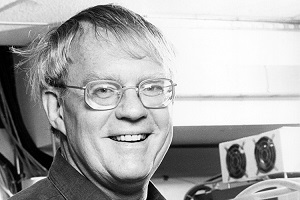
Charles Stuart Bowyer
Professor of Astronomy, Emeritus
Stuart (Stu) Bowyer passed away in Orinda, California, on September 23, 2020, from complications associated with Covid-19.
Stu was born on August 2, 1934, in Toledo, Ohio. He attended grade school at a one-room facility a mile from his father’s farm in Orland Park, Illinois. He graduated from Orland Park High School as the valedictorian of his class. He received a Bachelor of Arts degree from Miami University of Ohio and a Ph.D. in physics from the Catholic University of America in 1965. As a graduate student he was part of a team that discovered the X-ray emitting source Cygnus X-1, which was subsequently recognized as a black hole, the first ever to be found. He continued to be involved in the early days of X-ray astronomy at the Naval Research Laboratory in Washington, D.C. He joined the faculty at Berkeley in 1968. In 1989, Bowyer founded the Center for Extreme Ultraviolet Astrophysics (EUV) in Berkeley. He became Professor Emeritus in 1994 but continued his research as the Director of the Center for EUV.
Bowyer created the field of extreme ultraviolet astronomy and he invented or developed many of the instruments that are the mainstays of this field today. He was the first astronomer to believe that at wavelengths longer than X-rays, but shorter than visible ultraviolet radiation, there would be observable emission from hot objects throughout the universe. His colleagues told him that any such radiation would be absorbed by hydrogen in the interstellar medium and the Earth’s atmosphere. He persisted. Using balloons, sounding rockets, the Apollo-Soyuz mission in 1975, and finally a dedicated satellite called the Extreme Ultraviolet Explorer (EUVE), he proved them all wrong: there were enough gaps in the medium for one to detect this radiation out to great distances in some directions. He established UC Berkeley as the powerhouse in EUV astronomy. The instrumentation for the EUVE was built in-house at the Berkeley Space Sciences Laboratory, which, at the peak of this effort, employed more than 150 engineers and scientists. The 7,000-pound satellite was launched in June 1992 and remained operational for eight years, identifying more than a thousand sources of ultraviolet radiation in the sky. Astonishingly, Stu even convinced NASA to allow the Center for EUV Astrophysics to take on the operational control of the EUVE mission, something previously reserved for NASA centers. The reduction and archiving of the data obtained from the satellite, and the analysis of the scientific results, were also carried out at Berkeley. Stu was one of the first, if not the very first, scientist to become a principal investigator of an entire NASA mission.
Bowyer also investigated the nature of the interstellar medium and he developed one of the first searches for extraterrestrial intelligence (SETI). He was inspired by the 1971 Project Cyclops Report from Stanford/NASA/Ames Research Center, which argued that the search for extraterrestrial intelligent life was a legitimate scientific undertaking in a comprehensive space program and proposed using an array of telescopes to search for radio signals; the original project was not funded. With Mike Lampton, a colleague at the UC Space Sciences Lab, Stu conceived a way to make SETI observations commensally with the UC’s 85-foot radio telescope at the Hat Creek Radio Observatory. He recruited Jill Tarter because she knew how to program an obsolete PDP-8/S computer and a 100 channel PAR autocorrelator. She contributed the acronym SERENDIP (Search for Extraterrestrial Radio Emission from Nearby Developed Intelligent Populations), and Stu gave birth to what would eventually become the Berkeley SETI Research Center, with a dynamic and robust search agenda funded by Breakthrough Listen.
Stuart Bowyer received many awards and honors, including the NASA Technical Achievement Award, the NASA Exceptional Scientific Achievement Award, the Royal Order of Aerobee Rocketeers, the Humboldt Foundation Senior Scientist, the Honorary Doctor of Science from Miami University of Ohio, the Alumni Achievement Award in Science from the Catholic University, an Honorary Doctor of Philosophy from the Catholic University, the NASA ATLAS 1 Award, the NASA-DARA Orpheus-SPAS Award, the NASA Distinguished Public Service Award, the Spanish Ministry of Education and Science Award, the ASTRO-SPAS Mission 11 Award, the Computerworld/Smithsonian Science Award, and the COSPAR Massey Award.
Over his career, Bowyer authored or coauthored over 500 refereed scientific papers and his work is cited in more than 10,000 publications. He trained about 30 PhD students and supervised many post-doctoral fellows. He attracted extremely bright young scientists, many of whom have grown into world leaders in astronomy and astrophysics. He took great pride in this achievement.
Stu’s colleagues and friends remember him as being bold and brash and larger than life, never doing things by half-measure, but throwing himself completely into whatever he took on. His zest for life and fun knew no bounds. He was tall and powerfully built and his booming voice matched his stature and his enthusiasm. He was not easy to convince but gave total support once the value of a good idea became clear. He had detractors as well as admirers. He treated his research group to beer and pizza at a local establishment every Friday after work. He organized many memorable parties at home, where he and his wife were tireless and generous hosts.
Stu is survived by his wife, Jane, his sons, William and Robert, his daughter, Elizabeth, and five grandchildren. He leaves a splendid legacy of two new fields of scientific exploration.
Forrest Mozer
Jill Tarter
2021
